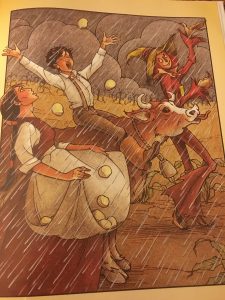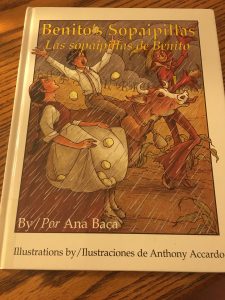
Title: Benito’s Sopaipillas
Author: Ana Baca
Illustrator: Anthony Accardo
Publisher and Year: Piñata Books, 2006
Number of Pages: 26
Genre: Fiction
Analysis: Benito’s Sopaipillas is about a young girl,Cristina, learning about her family history. Her grandmother tells her a story about Cristina’s great grandfather Benito and his soup catchers also know as sopaipillas in Spanish that he made many years ago with his mother.
This book can function as a window for those who are not familiar with this culture and sopaipillas. Many people who read this book can learn a lot about the culture displayed throughout. Not only could the book function as a window, but it could also function as a mirror for those who are familiar with this culture. People of this culture can relate to this book and understand the story behind sopaipillas. Benito’s Sopaipillas can also function as a door for children who want to learn more about their family culture and history. Cristina learns a lot about her great grandfather Benito and his sopaipillas, so other children could want to learn about their family history.
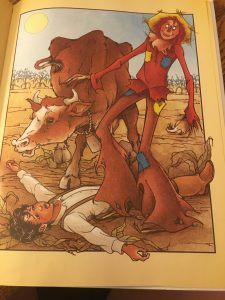
Perceptually, the front cover of the book had a mysterious feeling especially since they were cheering for rain, which was unclear the meaning behind the image on the front. From the front cover, there is both Spanish and English portrayed in the title, author and illustrator which showed that the book would both involve Spanish and English, without even opening to the first page.
Structurally, all the images are on the right side, with the entire left side full of text. The text is in two different languages, Spanish and English, which is why the text takes up an entire page. On each page, the image is framed, which only allows the audience to have a glimpse into the storyline, and not truly connect with the storyline and characters. Separating the English text and the Spanish text is a small image of a crop. This image changes throughout the book adapting to the storyline, three examples of this image can be seen below.
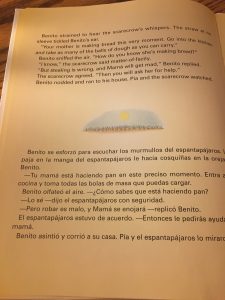
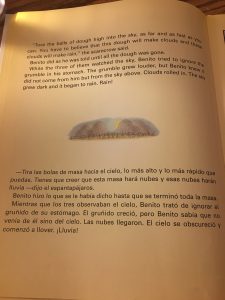

Ideologically, the book expresses stories about Cristina’s family history, showing to the audience that family history is important for all to learn about. Cristina learned about her own family’s culture and history, which could encourage the audience to also learn about their own family culture and history. Since the book contains text in both Spanish and English, the two different languages are useful depending on the audience. For example, if one person wanted to learn Spanish and knew English, he or she could read the English text and the Spanish text to learn the meaning of different words. The same is true for the opposite, if one person were to know Spanish, but not English, he or she could use both texts to learn English.
